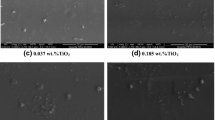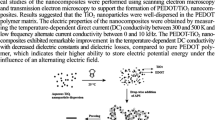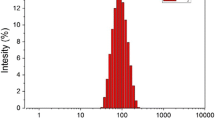Abstract
Titanium dioxide, TiO2, nanoparticles were prepared using the sol–gel method and mixed in various ratios with polyvinyl chloride (PVC) to create nanocomposite films. All prepared samples were examined using X-ray diffraction (XRD), and the average crystal size of TiO2 was around 50 nm. The dielectric properties of a TiO2/PVC nanocomposite film were thoroughly investigated. The dielectric constant exhibited a relaxation peak, which is attributed to the dynamic glass transition. The ε′ and ε′′ values increase with increasing temperature and decrease with increasing frequency. Moreover, they increased with the addition of TiO2 nanoparticles. The dielectric modulus (Mʹ, Mʹʹ) and electrical conductivity as a function of temperature and frequency were investigated. The frequency dependence of ac conductivity demonstrates that the conduction mechanism is governed by the correlated barrier hopping model. The complex impedance (Z*) of the prepared films was investigated. Relaxation time, activation energy, and other parameters were computed. The findings of this study were compared and discussed with those of similar nanocomposite films.












Similar content being viewed by others
References
Cho S, Choi W (2001) Solid-phase photocatalytic degradation of PVC–TiO 2 polymer composites. J Photochem Photobiol A: Chem 143:221
Fang L, Y-h Song, X-n. Zheng, S-h Chen, P-h Da, Zheng Q (2010) Influence of lanthanum stearate and calcium/zinc stabilizers on stabilization efficiency of dibutyltin dilaurate to polyvinyl chloride. Chinese J Polym Sci 28:637
Yoo H, S.-YeopKwak, (2011) TiO2-encapsulating PVC capable of catalytic self-suppression of dioxin emission in waste incineration as an eco-friendly alternative to conventional PVC. Appl Catal B Environ 104:193
Liu F, Liu H, Li X, Zhao H, Zhu D, Zheng Y, Li C (2012) Nano-TiO2@Ag/PVC film with enhanced antibacterial activities and photocatalytic properties. Appl Surf Sci 258:4667
Olad A, Behboudi S, Entezami AA (2013) Effect of polyaniline as a surface modifier of TiO 2 nanoparticles on the properties of polyvinyl chloride/TiO 2 nanocomposites. Chinese J Polym Sci 31:481
Mansour ShA, Elsad RA, Izzularab MA (2016) Dielectric properties enhancement of PVC nanodielectrics based on synthesized ZnO nanoparticles. J Polym Res 23:85
Mahmoud WE, Al-Ghamd AA (2011) The influence of Cd(ZnO) on the structure optical and thermal stabilities of polyvinyl chloride nanocomposites. Poly compos 32:1143–1147
Abouhaswa AS, Taha TA (2020) Tailoring the optical and dielectric properties of PVC/CuO nanocomposites. Polym Bull 77:6005–6016
Ebnalwaled AA, Thabet A (2016) Controlling the optical constants of PVC nanocomposite films for optoelectronic applications. Synth Met 220:374–383
Estabrak T. Abdullah, Asama Naje N (2011) AC electrical and dielectric properties of PVC-MWCNT nanocomposites. Indian J Sci Technol 4:731–735
Abdel-Baset T, Elzayat M, Mahrous S (2016) Characterization and optical and dielectric properties of polyvinyl chloride/silica nanocomposites films. J Polym Sci Int. https://doi.org/10.1155/2016/1707018
Aqib Muzaffar M, Ahamed B, Kalim Deshmukh SK, Pasha K (2020) Dielectric properties and electromagnetic interference shielding studies of nickel oxide and tungsten oxide reinforced polyvinylchloride nanocomposites. Polym-Plast Technol Mater 59:1667–1678
Wu W, Liang S, Shen L, Ding Z, Zheng H, Su W, Wu L (2012) Preparation, characterization and enhanced visible light photocatalytic activities of polyaniline/Bi3NbO7 nanocomposites. J Alloys Comp 520:213
Ramadoss A, Kim SJ (2013) Vertically aligned TiO2 nanorod arrays for electrochemical supercapacitor. J Alloys Comp 561:262
Ambade SB, Ambade RB, Mane RS, Lee GW, Shaikh SF, Patil SA (2013) Highly efficient and stable DSSCs of wet-chemically synthesized MoS 2 counter electrode. dalton Transactions. Chem Commun 28:2921
Han B, Kim SJ, Hwang BM, Kim SB, Park KW (2013) Single-crystalline rutile TiO2 nanowires for improved lithium ion intercalation properties. J Power Sources 222:225
Nakata K, Fujishima A (2012) TiO2 photocatalysis: Design and applications. J Photochem Photobiol C: Photochem Rev 13:169
Fabrega C, Andreu T, Tarancon A, Flox C, Morata A, Barrio LC, Morante JR (2013) Optimization of surface charge transfer processes on rutile TiO2 nanorods photoanodes for water splitting. Int J Hydrogen Energy 38:2979
Ding SN, Gao BH, Shan D, Suna YM, Cosnier S (2013) TiO2 nanocrystals electrochemiluminescence quenching by biological enlarged nanogold particles and its application for biosensing. Biosens Bioelectron 39:342
Haider AJ, Jameel ZN, Al-Hussaini IHM (2019) Review on: titanium dioxide applications. Energy procedia 157:17
Ortiz RP, Facchetti A, Marks TJ (2010) High- k organic, inorganic, and hybrid dielectrics for low-voltage organic field-effect transistors. Chem Rev 110:205
Taha TA, Ismail Z, Elhawary MM (2018) Structural, optical and thermal characterization of PVC/SnO2 nanocomposites. Appl Phys A 124:307
Da Silva MA, Vieira MGA, Maçumoto ACG, Beppu MM (2011) Polyvinylchloride (PVC) and natural rubber films plasticized with a natural polymeric plasticizer obtained through polyesterification of rice fatty acid. Polym Test 30(5):478
Dong Y, Wang Y, Cai T, Kou L, Yang G, Yan Z (2014) Preparation and nitrogen-doping of three-dimensionally ordered macroporous TiO2 with enhanced photocatalytic activity. Ceram Int 40:11213
Nirmala R, Jeong JW, Navamathavan R, Kim HY (2011) Synthesis and electrical properties of TiO 2 nanoparticles embedded in polyamide-6 nanofibers via electrospinning. Nano-Micro Letters 3(1):56–61
Lin DJ, Chang CL, Huang FM, Cheng LP (2003) Effect of salt additive on the formation of microporous poly(vinylidene fluoride) membranes by phase inversion from LiClO4/Water/DMF/PVDF system. Polymer 44:413
Alexander L, Klug HA (1950) Determination of Crystallite Size with the X‐Ray Spectrometer. J Appl Phys 21:137
Taha TA (2017) Optical and thermogravimetric analysis of Pb3O4/PVC nanocomposites. J Mater Sci: Mater Electron 28:12108
Elashmawi IS, Hakeem NA, Marei LK, Hanna FF (2010) Structure and performance of ZnO/PVC nanocomposites. Physica B 405:4163–4169
Alghunaim NS (2018) Structural, thermal, dielectric spectroscopic and AC impedance properties of SiC nanoparticles doped PVK/PVC blend. Results in Physics 9:1136
Mohammed G, El Sayed AM, El-Gamal S (2020) Effect of m nitrates on the optical, dielectric relaxation and porosity of PVC/PMMA Membranes (M = Cd, Co, Cr or Mg). J Inorg Organomet Polym 30:1306
Ramesh S, Liew C (2013) Dielectric and FTIR studies on blending of [xPMMA–(1−x)PVC] with LiTFSI. Measurement 46:1650
Arya A, Sharma AL (2018) Structural, electrical properties and dielectric relaxations in Na+-ion-conducting solid polymer electrolyte. J Phys: Condensed Mat 30(16):165402
Laurati M, Sotta P, Long DR, Fillot LA, Arbe A, Alegria A, Embs JP, Unruh T, Schneider GJ, Colmenero J (2012) Dynamics of water absorbed in polyamides. Macromolecules 45:1676
Tsangaris GM, Psarras GC, Kouloumbi N (1998) Electric modulus and interfacial polarization in composite polymeric systems. J Mater Sci 33:2027
McCrum NG, Read BE, Williams G (1967) An elastic and dielectric effects in polymeric solids. Wiley, New York
Macedo PB, Moynihan CT, Bose R (1972) The role of ionic diffusion in polarisation in vitreous ionic conductors. Phys Chem Glasses 13:171
Kim JS (2001) Electric modulus spectroscopy of lithium tetraborate (Li2B4O7) single crystal. J Phys Soc Jpn 70:3129
Fan L, Dang Z, Wei G, Nan CW, Li M (2003) Effect of nanosized ZnO on the electrical properties of (PEO)16LiClO4 electrolytes. Mater Sci Eng B 99:340
Havriliak S, Negami S (1966) A complex plane analysis of α-dispersions in some polymer systems. J Polym Sci C 14:99
Adohi BP, Brosseau C (2009) Dielectric relaxation in particle-filled polymer: Influence of the filler particles and thermal treatments. J Appl Phys 105(5):054108
Fleer G, Stuart MAC, Scheutjens JMHM, Cosgrove T, Vincent B (1993) Polymers at interfaces. Chapman and Hall, London
Jones RA (1999) The dynamics of thin polymer films. Curr Opin Colloid Interface Sci 4:153
Ferry JD (1980) Viscoelastic properties of polymers, 3rd edn. Wiley, New York
Adachi K, Hirano H (1998) Slow dielectric relaxation of cis-polyisoprene near the glass transition temperature. Macromolecules 31:3958
Schönhals A (1993) Relation between main and normal mode relaxations for polyisoprene studied by dielectric spectroscopy. Macromolecules 26:1309
Khalil R (2017) Impedance and modulus spectroscopy of poly(vinyl alcohol)-Mg[ClO4]2 salt hybrid films. Appl Phys A 123:422
Sen S, Choudhary RNP, Pramanik P (2007) Structural and electrical properties of Ca2+-modified PZT electroceramics. Physica B 387:56
Behera B, Nayak P, Choudhary RNP (2007) Impedance spectroscopy study of NaBa2V5O15 ceramic. J Alloys Compd 436:226
Delgado A, García-Sanchez MF, M’Peko J-C, Ruiz-Salvador AR, RodríguezGattorno G, Echevarría Y, Fernandez-Gutierrez F (2003) An elementary picture of dielectric spectroscopy in solids: physical basis. J Chem Educ 80:1062
Gerhardt R (1994) Impedance and dielectric spectroscopy revisited: distinguishing localized relaxation from long-range conductivity. J Phys Chem Solids 55:1491
Cao W, Gerhardt R (1990) Calculation of various relaxation times and conductivity for a single dielectric relaxation process. Solid State Ion 42:213
Dwivedi RK, Kumar D, Parkash O (2001) Valence compensated perovskite oxide system Ca1− x La x Ti1− x Cr x O3 Part III Impedance spectroscopy. J mater Sci 36(15):3657–65
Singh P, Singh P, Singh S, Parkash O, Kumar D (2008) Electrical conduction behavior and immittance analysis of Gd and Mn substituted strontium titanate. J Mater Sci 43:989
Sinha S, Chatterjee SK, Ghosh J, Meikap AK (2017) Analysis of the dielectric relaxation and ac conductivity behavior of polyvinyl alcohol-cadmium selenide nanocomposite films. Polym Compos 38:287
Macdonald JR (1987) Impedance spectroscopy. Wiley, Newyork, pp 12–23
Almond DP, Hunter CC, West AR (1984) The extraction of ionic conductivities and hopping rates from a.c. conductivity data. J Mater Sci 19:3236
Jonscher AK (1977) The ‘universal’ dielectric response. Nature 267:673
Elliot SR (1987) A.c. conduction in amorphous chalcogenide and pnictide semiconductors. Adv Phys 36:135
Pike GE (1972) AC conductivity of scandium oxide and a new hopping model for conductivity. Phys Rev B 6:1572
Roy AS, Gupta S, Sindhu S, Parveen A, Ramamurthy PC (2013) Dielectric properties of novel PVA/ZnO hybrid nanocomposite films. Compos Part B: Eng 47:314–9
Schmidbauer E, Schmid-Beurmann P (2004) Electrical conductivity and thermopower of Fe-phosphate compounds with the lazulite-type structure. J Solid State Chem 177:207
Ben Taher Y, Oueslati A, Maaloul NK, Khirouni K, Gargouri M (2015) Conductivity study and correlated barrier hopping (CBH) conduction mechanism in diphosphate compound. Appl Phys A 120:1537
Author information
Authors and Affiliations
Corresponding author
Additional information
Publisher's Note
Springer Nature remains neutral with regard to jurisdictional claims in published maps and institutional affiliations.
Rights and permissions
About this article
Cite this article
Abdel‑Baset, T.A., Abou Elfadl, A. Study of dielectric relaxation and charge transport of titanium dioxide-polyvinyl chloride nanocomposites. Polym. Bull. 79, 10157–10174 (2022). https://doi.org/10.1007/s00289-021-04000-5
Received:
Revised:
Accepted:
Published:
Issue Date:
DOI: https://doi.org/10.1007/s00289-021-04000-5




